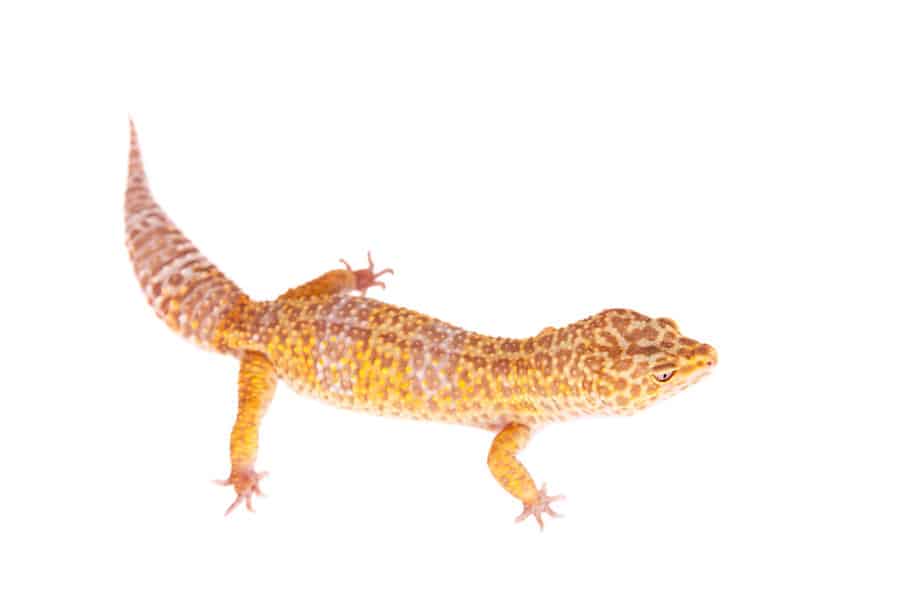One of the most fascinating parts of a leopard gecko’s body is its tail. It serves a variety of functions, from communication to self-defense. But how should a healthy leopard gecko tail look?
Healthy leopard gecko tails are usually fat. After all, these tails are designed to be fat reservoirs for when things get rough. One of the major signs that your leopard gecko is sick is that its tail is getting thinner and thinner.
What does a healthy leopard gecko’s tail look like?

A healthy leopard gecko’s tail is fat and has the same patterns, tone, and texture as the rest of the reptile’s body.
Keep in mind – some leopard geckos have tails with a slightly different color than that of their bodies. Ultimately, this is normal and healthy.
When it comes down to it, the thickness of a leopard gecko’s tail is a better indicator of its health than its color or pattern.
How fat should a leopard gecko’s tail be?
A healthy leopard gecko’s tail can be up to twice as fat as its body.
Ideally, the base should be the same size as the rest of your gecko’s body and should start getting thicker around ½ inch down before tapering off again at the end.
One of the major functions of a leopard gecko’s tail is to trick predators into thinking that it’s the main part of the body that they should attack.
That’s why it can even regenerate when cut off.
How to keep a leopard gecko’s tail healthy?
To keep your leopard gecko’s tail healthy, you have to:
Provide a balanced diet
Leopard geckos need to eat a balanced diet to maintain their fat reservoirs regularly. As such, ensure that you provide your reptile with various worms that meet their nutritional needs.
If you’re at a loss on where to start, a couple of trusted staples are mealworms and crickets. However, ensure that you incorporate worms with higher calcium to phosphorus ratios, like black soldier flies.
Also, remember to gut load your feeder insects and dust them beforehand to make them more nutritious.
Beyond that, ensure you feed your leopard gecko regularly and only offer narrower insects than the space between its eyes.
Provide enough water
If you want to keep your leopard gecko’s tail healthy, you must ensure its water bowl is always full. Not only does this help prevent dehydration, but it also allows your gecko to bathe regularly, reducing its chances of parasite infection.
Maintain optimal tank temperatures
When your leopard gecko tank isn’t set to optimal temperatures, it can compromise your reptile’s immunity. This can cause diseases that can make it lose significant tail fat.
Also, extremely low tank temperatures can force your leopard gecko to enter brumation and depend on its fat reservoirs to survive.
However, your leopard gecko shouldn’t lose too much weight during brumation. If you notice that they have lost over 10% of their body fat, take them to the vet immediately.
What are the signs that your leopard gecko’s tail is unhealthy?
The first sign that your leopard gecko’s tail is unhealthy is that it is skinny – it can even look like a thin stick. This is known as tail rot.
Such tails also tend to be discolored and dull. The skin on the tail may even seem wrinkled and dry. Some attribute this unpleasant appearance to deoxygenation of the tail area.
What disease can make your leopard gecko’s tail skinny?
The main health condition associated with a skinny tail in leopard geckos is Stick Tail Disease.
Most cases of this disease are caused by a parasite called Cryptosporidiosis.
This protozoan parasite usually affects your leopard gecko’s digestive system. As such, it causes diarrhea, loss of appetite, and weight loss.
To make matters worse, this parasite is too tiny to be seen in your leopard gecko’s stool, even if your vet uses a microscope.
So to effectively diagnose this disease, your vet will have to run a special kind of test known as a PCR test on your gecko’s fresh stool.
However, this type of test isn’t available in every animal hospital, and other diseases have similar symptoms to Cryptosporidiosis infection, making diagnosis difficult.
A good example is Salmonella – a bacterial infection that causes weight loss in the tail. But what makes Salmonella dangerous is the fact that it can quickly spread to humans and other pets.
Fortunately, Salmonella is easier to treat than Cryptosporidiosis. The latter has been known to resist treatment in some leopard geckos even when the necessary medication is administered.
As such, things can get so bad that your vet may recommend euthanizing your reptile to stop its suffering. Alternatively, your leopard gecko may still test positive for a while, even though its symptoms have subsided.
Ultimately, such leopard geckos should be quarantined and not allowed to breed with others.
How long can a leopard gecko live off its tail fat reservoirs?
If you stop feeding your leopard gecko, it can survive on its tail fat reservoirs for between one and three months.
Ultimately, the exact amount of time it can last depends on the size of its tail and its metabolic needs.
How do you take care of a leopard gecko that has recently lost its tail?
If your leopard gecko has recently lost its tail, you can do the following to keep it healthy as it regrows a new one:
- Keep the leopard gecko housed alone so that it doesn’t have to compete for resources while struggling to heal
- Keep the tank clean to avoid bacterial infections
- Don’t hold the reptile by its tail
- Provide a balanced diet
Remember, avoiding frequent handling is key to preventing gecko tail loss in the first place.
Final thoughts
Ultimately, a healthy leopard gecko tail looks fat and blends well with the rest of your reptile’s body. After all, these tails are designed to confuse predators as much as possible!
